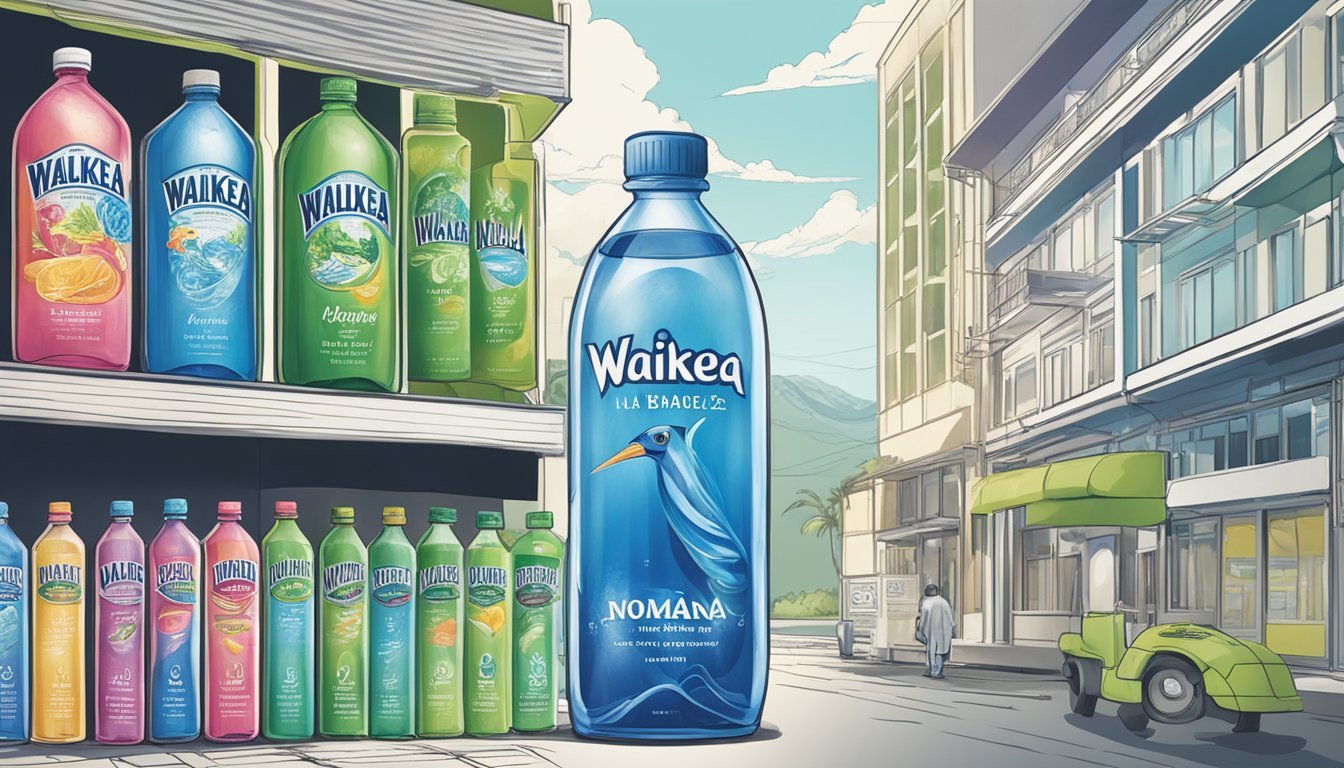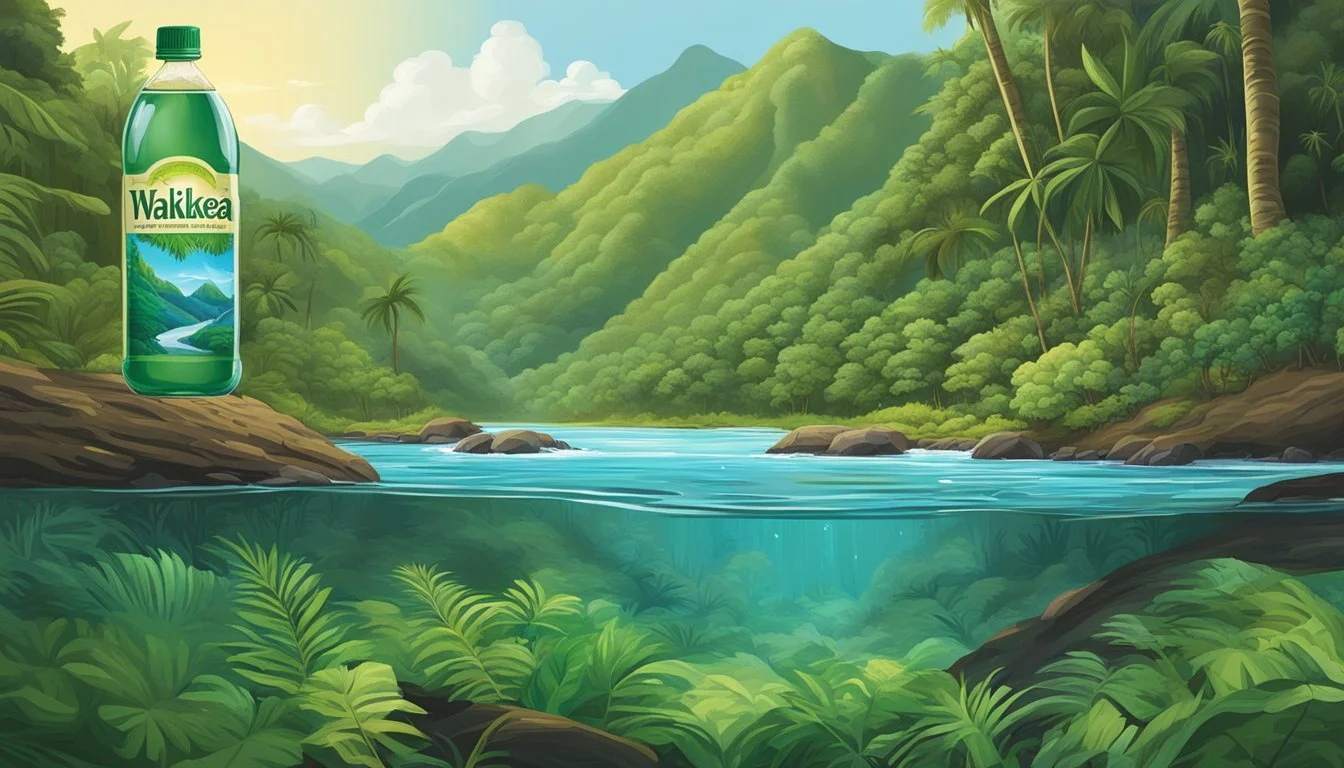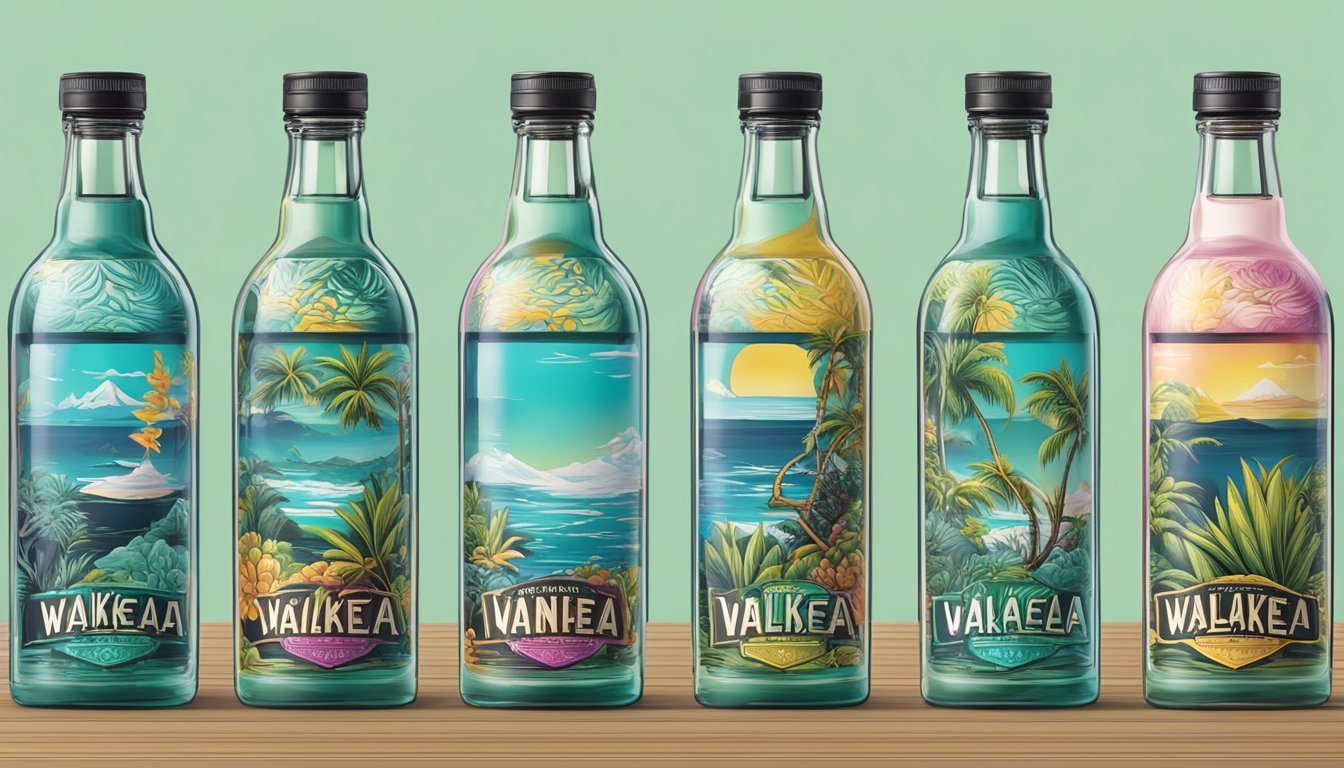Waiakea vs. Liquid Death
A Comprehensive Comparison of Bottled Water Quality
In the competitive world of bottled water, Waiakea and Liquid Death stand out as two unique brands catering to different consumer preferences. Waiakea, sourced from the Hawaiian volcanoes, is known for its naturally alkaline water, rich in minerals and electrolytes, making it a popular choice for health-conscious individuals. On the other hand, Liquid Death, with its striking branding and aluminum cans sourced from the Austrian Alps, appeals to those looking for an edgy, environmentally friendly option.
Waiakea's volcanic water not only offers a crisp, clean taste but also contributes to the environment through sustainable practices, such as using recyclable packaging and participating in reforestation initiatives. Meanwhile, Liquid Death's commitment to "murdering your thirst" extends beyond its bold imagery, with the company prioritizing eco-friendliness by using recyclable aluminum cans and supporting global clean drinking initiatives.
For consumers debating between these brands, the choice often boils down to personal preferences in taste, packaging, and brand values. Both Waiakea and Liquid Death offer premium hydration options, each with its own set of distinguishing features that cater to varied consumer needs.
Origins and Sources of the Brands
Waiakea and Liquid Death obtain their water from distinct and unique locations, each offering specific environmental benefits and attributes. These origins contribute significantly to the taste, purity, and perceived healthiness of both brands.
Waiakea: Hawaiian Volcanic Water
Waiakea sources its water from the slopes of the Mauna Loa Volcano in Hawaii. This area is renowned for its pristine environment and natural filtration systems. Rainfall filters through thousands of feet of volcanic rock, enriching the water with minerals like calcium, magnesium, and silica.
This process also imparts a natural alkalinity to the water, which is often marketed as beneficial for health. The aquifers in this region ensure a fresh and abundant supply of water. Waiakea differentiates itself as a brand that combines natural volcanic filtration with sustainable practices.
Liquid Death: Mountain Water from the Austrian Alps
Liquid Death sources its water from the Austrian Alps, a region celebrated for its crystalline mountain water. The water is drawn from natural springs and aquifers located high in the Alps. This method ensures it remains untouched by human activity until it is bottled.
The alpine environment provides a clean and mineral-rich source of water, free from pollutants. Liquid Death markets this purity alongside its unique, edgy branding, aiming to appeal to a younger, health-conscious audience. The water's spring source contributes to its clean taste and high quality.
Analyzing Health Impacts
When comparing Waiakea and Liquid Death, it's crucial to examine their mineral content and pH levels to understand their potential health benefits. Here, the focus is on the specific factors influencing health and hydration, such as mineral concentrations and the quality of the water.
Mineral Content Comparison
Waiakea water is known for its rich mineral content, including calcium, magnesium, potassium, and silica. Calcium and magnesium are vital for maintaining strong bones and muscles. Potassium plays a key role in regulating fluid balance and nerve signals. Silica supports connective tissue health.
Minerals in Waiakea Water:
Calcium
Magnesium
Potassium
Silica
Liquid Death, marketed primarily for its unique branding, contains fewer minerals. It focuses on pure mountain water without significant mineral enhancement. This makes it a less ideal choice for those specifically seeking the health benefits associated with mineral-rich water.
pH Levels and Water Quality
Waiakea boasts a naturally alkaline pH level of around 8.2, which can help neutralize acidity in the body. Alkaline water advocates believe that it aids in maintaining a balanced pH level, potentially reducing acid reflux and improving overall hydration efficiency.
Liquid Death has a pH close to neutral, between 7.0 and 7.9. While a neutral pH is generally safe and effective for hydration, it does not provide the same alkaline benefits as Waiakea.
Waiakea's water is also filtered through volcanic rock, which adds to its mineral content and quality. Liquid Death sources its water from mountain springs but does not offer the same alkaline properties.
In brief, while both Waiakea and Liquid Death provide clean, hydrating options, Waiakea's higher mineral content and alkaline pH level offer additional health benefits, particularly for those looking for enhanced hydration and better pH balance.
Environmental and Sustainability Considerations
Waiakea and Liquid Death both claim to prioritize environmental sustainability and responsible sourcing. This section examines their packaging methods and production processes to determine their effectiveness.
Packaging and Recycling
Waiakea uses 100% recycled PET (rPET) for its bottles, significantly reducing energy and water use. This boasts an 85% reduction in energy and a 99% decrease in water consumption compared to regular plastic bottles. Waiakea's efforts to reduce carbon emissions underscore its commitment to sustainability.
Liquid Death opts for aluminum cans, which are more easily recyclable than plastic. Aluminum has a higher recycling rate and can be recycled indefinitely. This choice helps reduce plastic waste and supports a circular economy. Liquid Death's use of aluminum over plastic showcases their focus on minimizing environmental impact.
Sourcing and Production Processes
Waiakea’s water comes from volcanic sources in Hawaii, naturally filtered through porous volcanic rock. This filtration process adds beneficial minerals and enhances the water's purity. Waiakea is also a certified Carbon Neutral company, with initiatives such as donating 5% of its revenue to non-profit organizations.
Liquid Death sources its water from Austria’s Alps. Their production process emphasizes sustainability, using BPA-free materials and ensuring responsible water sourcing. Although less highlighted than Waiakea, Liquid Death strives to maintain a minimal carbon footprint through efficient logistics and fewer single-use plastics.
These approaches by Waiakea and Liquid Death emphasize the importance they place on environmental and sustainability practices in their sourcing and production methods.
Taste and Quality Difference
The taste and quality differences between Waiakea and Liquid Death arise from their unique sources and processing methods. Waiakea's volcanic filtration impacts its mineral content and flavor, while Liquid Death's mountain spring origin and carbonation provide distinct characteristics.
Flavor Profiles of Waiakea and Liquid Death
Waiakea water, sourced from the Mauna Loa volcano in Hawaii, has a unique mineral composition due to volcanic filtration. This process gives the water a naturally alkaline pH level of 8.2, contributing to a subtly sweet and smooth taste. The presence of electrolytes like calcium, magnesium, and potassium enhances its refreshing quality.
Liquid Death, on the other hand, offers a crisp and clean taste typical of Alpine spring water. Its unflavored version is still, while the flavored types include light carbonation for a fizzy experience. The carbonation levels are balanced, avoiding an overly harsh or metallic taste. This makes Liquid Death a versatile choice for those who prefer both still and sparkling water options.
Consumer Perceptions and Reviews
Consumer reviews highlight Waiakea's distinct mineral-rich flavor and silky texture. Many appreciate the subtle sweetness and smooth finish, which they find highly refreshing. Positive aspects often mentioned include its clean taste and hydrating properties, thanks to naturally occurring electrolytes.
Liquid Death receives praise for its marketing and branding, appealing especially to a younger demographic. Reviewers commend the crispness and purity of its still water and the balanced carbonation of its flavored versions. Negative feedback is rare but sometimes mentions the premium pricing as a downside. Both brands are favored for their eco-friendly packaging but cater to different taste preferences and lifestyle choices.
Market Presence and Availability
Both Waiakea and Liquid Death have carved out significant niches in the bottled water industry. Their market presence is defined by strategic retail placements and strong brand partnerships that enhance their visibility and customer reach.
Retail and Online Distribution
Waiakea is available in a variety of retail locations, including high-end stores like Whole Foods. Its distribution network extends to specialty health stores and supermarkets across multiple states. Additionally, Waiakea leverages online platforms such as Amazon, making it accessible to a broader audience. The brand’s reach is further extended through export agreements, ensuring international availability.
Liquid Death, in contrast, positions itself uniquely with its can packaging. Initially available online, it quickly expanded to retail distribution. Today, it is found in major retailers and convenience stores. Liquid Death has a significant presence on e-commerce platforms, reinforcing its accessibility. The brand's online and retail strategies have contributed to its rapid success, making it a popular choice among consumers seeking both still and sparkling water options.
Brand Partnerships and Endorsements
Waiakea’s partnerships focus on co-branding with eco-friendly and health-conscious companies. It has been endorsed by influencers and health enthusiasts who align with its sustainable practices. Additionally, Waiakea engages in sponsorships of health and wellness events to further its brand presence. These efforts enhance its reputation as a premium, environmentally responsible choice.
Liquid Death takes a different approach with its edgy marketing. The brand has secured partnerships with unconventional endorsements from musicians and athletes. These collaborations help solidify its identity in the market. Liquid Death also sponsors major events and music festivals, leveraging its unique branding to appeal to a younger, more alternative audience. This aggressive marketing enhances its visibility and attracts a loyal fanbase.
Price Comparison and Economic Considerations
When comparing the prices of Waiakea and Liquid Death, various factors come into play.
Waiakea is generally seen as a premium brand due to its unique source from Hawaiian volcanic waters. This contributes to a higher cost. A case of Waiakea typically ranges around $30-$35 for 12 1-liter bottles, reflecting its artisanship and premium pricing.
In contrast, Liquid Death also positions itself as a premium water brand with a unique marketing appeal. The cost is slightly lower, with a case of 12 16.9-ounce cans usually priced around $20-$25. Despite the premium branding, Liquid Death targets a wider audience.
Comparisons at a Glance
Brand Package Size Price Range (USD) Packaging Type Waiakea 12 x 1 liter bottles $30-$35 Sustainable plastic Liquid Death 12 x 16.9 oz cans $20-$25 Aluminum cans
For those on a budget, Liquid Death may offer a more economical choice per ounce. Waiakea’s premium price highlights its unique source and bottled packaging which aims to provide additional mineral benefits.
Economic considerations also include additional costs like shipping fees, which might vary based on location and retailer. Lastly, potential buyers might weigh the brands' value propositions differently, choosing based on either cost-effectiveness or perceived health benefits.
Health and Safety Standards
When evaluating Waiakea and Liquid Death bottled water, it's essential to consider their health and safety standards. This section reviews quality certifications and potential contaminants to help consumers make informed decisions.
Quality Certifications and Endorsements
Both Waiakea and Liquid Death adhere to stringent health and safety standards. Waiakea has received certifications from the International Bottled Water Association (IBWA). This endorsement indicates compliance with rigorous quality control measures.
Liquid Death’s manufacturing process is frequently inspected by federal government agencies. These inspections ensure that their water meets or exceeds standard health and safety guidelines.
Regular testing for contaminants, heavy metals, and microbial hazards is critical. Both brands routinely publish test results for transparency. Such certifications and regular testing help maintain consumer trust.
Contamination and Safety Concerns
Monitoring for contaminants like lead and other heavy metals is crucial for consumer safety. Waiakea recently faced a recall due to consumer complaints, indicating a need for increased scrutiny.
Liquid Death has not reported significant contamination issues and maintains a clean safety track record.
Consumer Reports tested various bottled waters and found contaminants in some brands, emphasizing the importance of regular testing. Both Waiakea and Liquid Death publish their findings, ensuring transparency.
Ensuring the absence of harmful substances through regular monitoring is vital for protecting consumer health.
Alternatives to Waiakea and Liquid Death
There are various bottled water brands, tap water solutions, and reusable options that offer additional benefits over Waiakea and Liquid Death. It is important for consumers to explore all options to find the best hydration solution that fits their preferences and lifestyle.
Comparing Other Bottled Water Brands
Fiji Water and Evian are notable alternatives, both sourced from natural springs and renowned for their smooth taste. Fiji Water is bottled from an aquifer in the Yaqara Valley of Viti Levu, Fiji, and Evian hails from the Cachat Spring in Evian-les-Bains, France.
Essentia Water, known for its high pH of 9.5, offers a clean and crisp flavor favored by those seeking alkaline water. Dasani, produced by Coca-Cola, and Topo Chico, a popular mineral water brand from Mexico, are also widely available. For those who enjoy flavored options, La Croix provides a range of sparkling waters infused with natural flavors.
Tap Water and Filtration Solutions
Tap water can be a convenient and cost-effective alternative, especially when combined with effective filtration methods. Water filtration systems, such as Brita, PUR, and advanced reverse osmosis systems, can remove contaminants and improve taste.
In some regions, tap water can be as safe and tasty as bottled water, depending on the local water quality and infrastructure. Investing in a high-quality filtration system ensures clean water for consumption and can be a sustainable option, reducing plastic waste.
Reusable Bottles and Water Ionizers
Reusable bottles, like those from Hydro Flask, S'well, and Nalgene, provide an environmentally-friendly alternative for staying hydrated. These bottles are available in various sizes, styles, and materials, catering to a wide range of preferences. Using a reusable bottle can significantly cut down the need for single-use plastics.
Water ionizers, such as those from brands like Kangen or Tyent, can offer advanced filtration and the option to produce alkaline water. Ionized water enthusiasts believe it has additional health benefits, though these claims require more scientific backing. Water ionizers can be a valuable addition to a healthy lifestyle, providing readily available ionized, alkaline water at home.
More About Waiakea
Icelandic Glacial vs Waiakea: Which Bottled Water is Better?
Mountain Valley Spring Water vs Waiakea: Which Bottled Water is Better?
Waiakea vs Kirkland Signature: Which Bottled Water is Better?
Waiakea vs Richard's Rainwater: Which Bottled Water is Better?
Waiakea vs Whole Foods Italian Still Mineral water: Which Bottled Water is Better?
More About Liquid Death
Aqua Carpatica vs Liquid Death: Which Bottled Water is Better?
Core Hydration vs Liquid Death: Which Bottled Water is Better?
Hawaii Volcanic vs Liquid Death: Which Bottled Water is Better?
Hawaiian Springs vs Liquid Death: Which Bottled Water is Better?
Ice Mountain vs Liquid Death: Which Bottled Water is Better?
Icelandic Glacial vs Liquid Death: Which Bottled Water is Better?
Liquid Death vs Cascade Mountain: Which Bottled Water is Better?
Liquid Death vs Crystal Geyser: Which Bottled Water is Better?
Liquid Death vs Crystal Lake: Which Bottled Water is Better?
Liquid Death vs Essence pH10: Which Bottled Water is Better?
Liquid Death vs Kirkland Signature: Which Bottled Water is Better?
Liquid Death vs Proud Source: Which Bottled Water is Better?
Liquid Death vs Richard's Rainwater: Which Bottled Water is Better?
Liquid Death vs Simple Truth: Which Bottled Water is Better?
Liquid Death vs Talking Rain AQA: Which Bottled Water is Better?
Liquid Death vs Whole Foods 365: Which Bottled Water is Better?
Liquid Death vs Whole Foods Italian Still Mineral water: Which Bottled Water is Better?
Mountain Valley Spring Water vs Liquid Death: Which Bottled Water is Better?
Nestle Pure Life vs Liquid Death: Which Bottled Water is Better?
Poland Spring vs Liquid Death: Which Bottled Water is Better?
Purely Sedona vs Liquid Death: Which Bottled Water is Better?
San Pellegrino vs Liquid Death: Which Bottled Water is Better?
Solan de Cabras vs Liquid Death: Which Bottled Water is Better?








